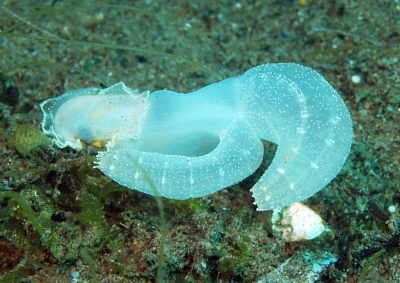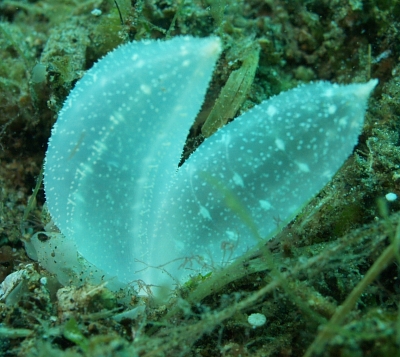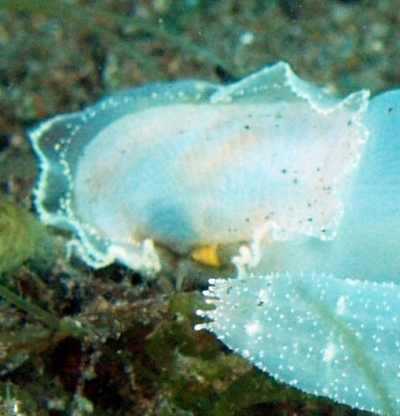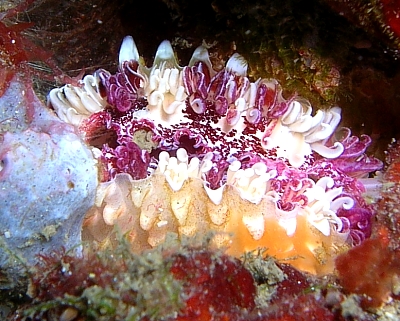Bivalves, Clams etc
Phylum: MOLLUSCA
Class: PELECYPODA
A place for messages on miscellaneous bivalves, clams etc
Authorship detailsRudman, W.B., 2007 (May 22) Bivalves, Clams etc. [In] Sea Slug Forum. Australian Museum, Sydney. Available from http://www.seaslugforum.net/find/bivalves
Related messages
Re: What is this?
August 18, 2008
From: John Taylor
Concerning message #21736:
Dear Bill
I have seen this image and video clip before - sent to me by Paul Scott. I am fairly confident that it is a member of Solecurtidae. Very similar images of Solecurtus swimming were published by Bromley and Asgaard in the Edinburgh Congress Bivalvia volume.
- Bromley, R.G and Asgaard, U, 1990. Solecurtus strigilatus: a jet propelled burrowing bivalve. pp313-320 [In:] The Bivalvia. Proceedings of a Memorial Symposium in Honour of Sir Charles Maurice Yonge, Edinburgh, 1986. Hong Kong University Press
Best
John Taylor
Natural History Museum, London.
j.taylor@nhm.ac.uk
Taylor, J. D., 2008 (Aug 18) Re: What is this?. [Message in] Sea Slug Forum. Australian Museum, Sydney. Available from http://www.seaslugforum.net/find/21815Thanks John,
I know its not a sea slug, but it's good to be able to clear up this little mystery. I wondered about Solecurtus but couldn't see any signs of the annulations on the siphons which I would have expected to see in that genus. After looking again at Willy Vanderweert's photos I can see that there are rings of white marks which must indicate the annulations normally found in species of this genus. For those of you unfamilar with Solecurtus, the 'annulations' I speak of are regular grooves around the siphons which make them look segmented. When attacked or nibbled by a predator, the bivalve is able to break off one or more of these segments as a replaceable sacrifice. [see autotomy page]. Clearly when the siphons are so inflated during swimming, the grooves disappear. One apparent difference between this species and Solecurtus strigilatus, is that the shell is covered with mantle lobes, - something not present in S. strigilatus.
Best wishes,
Bill Rudman
What is this?
August 11, 2008
From: Willy Vandeweert


In February - March this year we where on a diving trip in the Visayas, Philippines and we have seen a creature what we don't know what it is (probably a shell). If you go to the site http://dive4fun.magix.net/
and click on "wat is da" you see a movie of the creature moving.
Locality: Dauin, Visayas, 10m, Philipines, Pacific, 2 march 2008, vulkcanic sand. Length: 10cm. Photographer: Willy Vandeweert.
Can you help us?
Greetings
Willy
vandewwi@skynet.be
Vandeweert, W., 2008 (Aug 11) What is this?. [Message in] Sea Slug Forum. Australian Museum, Sydney. Available from http://www.seaslugforum.net/find/21736
Dear Willy,
I have never seem anything like it, but I am pretty sure it is a strange bivalve, with an internal shell. Most bivalves, like oysters, cockles etc., have the shell on the outside, protecting their internal body. They often have two tubes [siphons] which funnel water in and out of the shell and mantle cavity, which houses their gills and feeding apparatus. In your animal it looks like the siphons have become the largest part of the body and are able to close off the opening of their tube and blow up like a balloon, and somehow swim.
If you look at the close-up alongside, you will see that the end of one of the siphons is partly open [compare it with the two siphons in the middle photo where their ends are tightly closed]. Also in the photo alongside you can see the whitish shell through the layer of skin covering it. The whitish lines on the shell are almost certainly growth-lines, deposited as the shell grew.
If it is a bivalve, I have no idea what it is but have emailed a few colleagues to see if they do. It is possibly something no one has yet seen alive.
Best wishes,
Bill Rudman
Is this a seaslug?
May 29, 2007
From: Mirjam Broos

Dear Bill,
I would like to know if this "creature" is a seaslug. If yes, what kind of seaslug is it?
Locality: Teluk Kambahu, Lembeh Strait, ?, North Sulawesi, Indonesia, Celebes Sea, 10 october 2006, muckdiving. Length: ?. Photographer: Geert Prast.
Mirjam Broos
mirjam.broos@planet.nl
Broos, M., 2007 (May 29) Is this a seaslug?. [Message in] Sea Slug Forum. Australian Museum, Sydney. Available from http://www.seaslugforum.net/find/18961Dear Mirjam,
I must say when I first saw your photo I was a bit puzzled - and wished I could touch the animal. In the field, my first reaction to something puzzling - after watching it for a bit - is to gently touch it to see what it does. I am sure if I touched this it would have closed up because I think this is a bivalve of some sort - perhaps a Spondylus [= Thorny Oyster] a group which have spectacularly colourful and elaborate edges to the mantle flaps which line the inside of their shells, and in fact secrete the new shell as the animal grows.
Best wishes,
Bill Rudman
